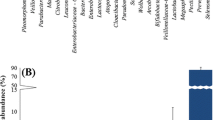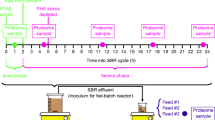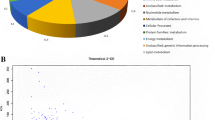Abstract
Synergistetes strain MFA1 is an asaccharolytic ruminal bacterium isolated based on its ability to degrade fluoroacetate, a plant toxin. The amino acid and peptide requirements of the bacterium were investigated under different culturing conditions. The growth of strain MFA1 and its fluoroacetate degradation rate were enhanced by peptide-rich protein hydrolysates (tryptone and yeast extract) compared to casamino acid, an amino acid-rich protein hydrolysate. Complete utilization and preference for arginine, asparagine, glutamate, glycine, and histidine as free amino acids from yeast extract were observed, while the utilization of serine, threonine, and lysine in free form and peptide-bound glutamate was stimulated during growth on fluoroacetate. A predominant peptide in yeast extract preferentially utilized by strain MFA1 was partially characterized by high-liquid performance chromatography-mass spectrometry as a hepta-glutamate oligopeptide. Similar utilization profiles of amino acids were observed between the co-culture of strain MFA1 with Methanobrevibacter smithii without fluoroacetate and pure strain MFA1 culture with fluoroacetate. This suggests that growth of strain MFA1 could be enhanced by a reduction of hydrogen partial pressure as a result of hydrogen removal by a methanogen or reduction of fluoroacetate.



Similar content being viewed by others
References
Vartoukian SR, Palmer RM, Wade WG (2007) The division “Synergistes”. Anaerobe 13:99–106
Godon JJ, Moriniere J, Moletta M, Gaillac M, Bru V, Delgenes JP (2005) Rarity associated with specific ecology niches in the bacterial world: the ‘Synergistes’ example. Environ Microbiol 7:213–224
Baena S, Fradeau ML, Ollivier B, Labat M, Thomas P, Garcia JL, Patel BKC (1999) Aminomonas paucivorans gen. nov., sp. nov., a mesophilic, anaerobic, amino-acid-utilizing bacterium. Int J Syst Evol Microbiol 49:975–982
Ganesan A, Sebastien C, Tarrade A, Dauga C, Bouchez T, Pelletier E, Le Paslier D, Sghir A (2008) Cloacibacillus evryensis gen. nov., sp. nov., a novel asaccharolytic, mesophilic, amino-acid-degrading bacterium within the phylum ‘Synergistetes’, isolated from an anaerobic sludge digester. Int J Syst Evol Microbiol 58:2003–2012
Zavarzina DG, Zhilina TN, Tourova TP, Kuznetsov BB, Kostrikina NA, Bonch-Osmolovskaya EA (2000) Thermanaerovibrio velox sp. nov., a new anaerobic, thermophilic, organotrophic bacterium that reduces elemental sulfur, and emended description of the genus Thermanaerovibrio. Int J Syst Evol Microbiol 50:1287–1295
Hugenholtz P, Hooper SD, Kyrpides NC (2009) Synergistetes. Environ Microbiol 11:1327–1329
Allison MJ, Mayberry WR, McSweeney CS, Stahl DA (1992) Synergistes jonesii, gen. nov., sp. nov.: a rumen bacterium that degrades toxic pyridinediols. Syst Appl Microbiol 15:522–529
Rees GN, Patel BKC, Grassia GS, Sheeny AJ (1997) Anaerobaculum thermoterrenum gen. nov., sp. nov., a novel, thermophilic bacterium which ferments citrate. Int J Syst Evol Microbiol 47:150–154
Jumas-Bilak E, Carlier JP, Jean-Pierre J, Citron D, Bernard K, Damay A, Gay B, Teyssier C, Campos J, Marchandin H (2007) Jonquetella anthropi gen. nov., sp. nov., the first member of the candidate phylum ‘Synergistetes’ isolated from man. Int J Syst Evol Microbiol 57:2743–2748
Looft T, Levine UY, Stanton TB (2013) Cloacibacillus porcurum sp. nov., a mucin-degrading bacterium from the swine intestinal tract and emended description of the genus Cloacibacillus. Int J Syst Evol Microbiol 63:1960–1966
Menes RJ, Muxi L (2002) Anaerobaculum mobile sp. nov., a novel anaerobic, moderately thermophilic, peptide-fermenting bacterium that uses crotonate as an electron acceptor, and emended description of the genus Anaerobaculum. Int J Syst Evol Microbiol 52:157–164
Plugge CM, Stams AJM (2001) Arginine catabolism by Thermanaerovibrio acidaminovorans. FEMS Microbiol Lett 195:259–262
McSweeney CS, Allison MJ, Mackie RI (1993) Amino acid utilization by the ruminal bacterium Synergistes jonesii strain 78-1. Arch Microbiol 159:131–135
Adams CJ, Redmond MC, Valentine DL (2006) Pure-culture growth of fermentative bacteria, facilitated by H2 removal: bioenergetics and H2 production. Appl Environ Microbiol 72:1079–1085
Soboh B, Linder D, Hedderich R (2004) A multisubunit membrane-bound [NiFe] hydrogenase and an NADH-dependent Fe-only hydrogenase in the fermenting bacterium Thermoanaerobacter tengcongenesis. Microbiology 150:2451–2463
Dahle H, Birkeland NK (2006) Thermovirga lienii gen. nov., sp. nov., a novel moderately thermophilic, anaerobic, amino-acid-degrading bacterium isolated from a North Sea oil well. Int J Syst Evol Microbiol 56:1539–1545
Magot M, Ravot G, Campaignolle X, Ollivier B, Patel BKC, Fardeau ML, Thomas P, Crolet JL, Garcia JL (1997) Dethiosulfovibrio peptidovorans gen. nov., sp. nov., a new anaerobic, slightly halophilic thiosulfate-reducing bacterium from corroding offshore oil wells. Int J Syst Evol Microbiol 47:818–824
Surkov AV, Dubinina GA, Lysenko AM, Glockner FO, Kuever J (2001) Dethiosulfovibrio russensis sp. nov., Dethiosulfovibrio marinus sp. nov. and Dethiosulfovibrio acidaminovorans sp. nov., novel anaerobic, thiosulfate- and sulfur-reducing bacteria isolated from ‘Thiodendron’ sulfur mats in different saline environments. Int J Syst Evol Microbiol 51:327–337
Davis CK, Webb RI, Sly LI, Denman SE, McSweeney CS (2012) Isolation and survey of novel fluoroacetate-degrading bacteria belonging to the phylum Synergistetes. FEMS Microbiol Ecol 80:671–684
Twigg LE, Wright GR, Potts MD (1999) Fluoroacetate content of Gastrolobium brevipes in Central Australia. Aust J Bot 47:877–880
Twigg LE, King DR (1991) The impact of fluoroacetate-bearing vegetation on native Australian fauna: a review. Oikos 61:412–430
Robison WH (1970) Acute toxicity of sodium monofluoroacetate to cattle. J Wildl Manag 34:647–648
Cohen SA, Michaud DP (1993) Synthesis of a fluorescent derivatizing reagent, 6-aminoquinolyl-N-hydroxysuccinimidyl carbamate, and its application for the analysis of hydrolysates amino acids via high performance liquid chromatography. Anal Biochem 211:279–287
Meltzer NM, Tous GI, Gruber S, Stein S (1987) Gas-phase hydrolysis of proteins and peptides. Anal Biochem 160:356–361
Rada V, Petr J (2000) A new selective medium for the isolation of glucose non-fermenting bifidobacteria from hen caeca. J Microbiol Methods 43:127–132
BD Biosciences (2006) Advanced bioprocessing. BD Bionutrients technical manual, 3rd edn. BD Biosciences, Sparks
Atasoglu C, Valdes C, Walker ND, Newbold JC, Wallace JR (1998) De novo synthesis of amino acids by the ruminal bacteria Prevotella bryantii B14, Selenomonas ruminantium HD4, and Streptococcus bovis ES1. Appl Environ Microbiol 64:2836–2843
Chen G, Strobel HJ, Russell JB, Sniffen CJ (1987) Effect of hydrophobicity on utilization of peptides by ruminal bacteria in vitro. Appl Environ Microbiol 53:2021–2025
Baena S, Fardeau ML, Labat M, Ollivier B, Garcia JL, Patel BKC (2000) Aminobacterium mobile sp. nov., a new anaerobic amino-acid-degrading bacterium. Int J Syst Evol Microbiol 50:259–264
Garcia JL (1990) Taxonomy and ecology of methanogens. FEMS Microbiol Rev 87:297–308
Savant DV, Shouche YS, Prakash S, Ranade DR (2002) Methanobrevibacter acididurans sp. nov., a novel methanogen from a sour anaerobic digester. Int J Syst Evol Microbiol 52:1081–1087
Lai M-C, Shu C-M, Chen S-C, Lai L-J, Chiou M-S, Hua JJ (2000) Methanosarcina mazei strain O1M9704, methanogen with novel tubule isolated from estuarine environment. Curr Microbiol 41:15–20
Maestrojuan GM, Boone DR (1991) Characterization of Methanosarcina barkeri MST and 227, Methanosarcina mazei S-6T, and Methanosarcina vacuolata Z-761T. Int J Syst Evol Microbiol 41:267–274
Samuel BS, Hansen EE, Mancester JK, Coutinho PM, Henrissat B, Fulton R, Latreille P, Kim K, Wilson RK, Gordon JI (2007) Genomic and metabolic adaptations of Methanobrevibacter smithii to the human gut. Proc Natl Acad Sci U S A 104:10643–10648
Bartlett GR, Barron ESG (1947) The effect of fluoroacetate on enzymes and on tissue metabolism. Its use for the study of the oxidation pathway of pyruvate metabolism. J Biol Chem 170:67–82
Kalnitsky G, Guzman Barron ES (1947) The effect of fluoroacetate on the metabolism of yeast and bacteria. J Biol Chem 170:83–95
Winfrey MR, Zeikus JG (1979) Anaerobic metabolism of immediate methane precursors in Lake Mendota. Appl Environ Microbiol 37:244–253
Goodwin S, Giraldo-Gomez E, Mobarry B, Switzenbaum MS (1991) Comparison of diffusion and reaction rates in anaerobic microbial aggregates. Microb Ecol 22:161–174
Iannotti EL, Kafhewitz D, Wolin MJ, Bryant MP (1973) Glucose fermentation products of Ruminococcus albus grown in continuous culture with Vibrio succinogenes: changes caused by interspecies transfer of H2. J Bacteriol 114:1231–1240
Robert C, Del’Homme C, Bernalier-Donadille A (2001) Interspecies H2 transfer in cellulose degradation between fibrolytic bacteria and H2-utilizing microorganisms from the human colon. FEMS Microbiol Ecol 205:209–214
Rychlik JL, May T (2000) The effect of a methanogen, Methanobrevibacter smithii, on the growth rate, organic acid production, and specific ATP activity of three predominant ruminal cellulolytic bacteria. Curr Microbiol 40:176–180
Scheifinger CC, Lineham B, Wolin MJ (1975) H2 production of Selenomonas ruminatium in the absence and presence of methanogenic bacteria. Appl Microbiol 29:480–483
Wildenauer FX, Winter J (1986) Fermentation of isoleucine and arginine by pure and syntrophic cultures of Clostridium sporenges. FEMS Microbiol Lett 38:373–379
Stams AJM (1994) Metabolic interactions between anaerobic bacteria in methanogenic environments. Antonie Van Leeuwenhoek 66:271–294
Thauer RK, Jungermann K, Decker K (1977) Energy conservation in chemotrophic anaerobic bacteria. Bacteriol Rev 41:100–180
van de Pas BA, Jansen S, Dijkema C, Schraa G, De Vos WM, Stams AJM (2001) Energy yield of respiration on chloroaromatic compounds in Desulfitobacterium dehalogenans. Appl Environ Microbiol 67:3958–3963
Mohn WW, Tiedje JM (1991) Evidence for chemiosmotic coupling of reductive dechlorination and ATP synthesis in Desulfomonile tiedjei. Arch Microbiol 157:1–6
Schumacher W, Holliger C (1996) The proton electron ratio of the menaquinone-dependent electron transport from dihydrogen to tetrachloroethene in ‘Dehalobacter restrictus’. J Bacteriol 178:2328–2333
Stickland L (1934) Studies in the metabolism of the strict anaerobes (genus Clostridium): the chemical reactions by which Cl. sporogenes obtains its energy. Biochem J 28:1746–1759
Diaz-Cardenas C, Lopez G, Patel BKC, Baena S (2010) Dethiosulfovibrio salsuginis sp. nov., an anaerobic, slightly halophilic bacterium isolated from a saline spring. Int J Syst Evol Microbiol 60:850–853
Acknowledgments
The authors thank E. J. Gagen for comments on the manuscripts. The research was partly funded by the Commonwealth Science and Industrial Research Organization (CSIRO) Office of Chief Executive postgraduate scholarship program and Meat and Livestock Australia. PH was supported by an ARC Discovery Outstanding Research Award (ARC-DP120103498).
Conflict of Interest
The authors declare that they have no conflict of interest.
Author information
Authors and Affiliations
Corresponding author
Electronic supplementary material
Below is the link to the electronic supplementary material.
ESM 1
(PDF 40 kb)
Rights and permissions
About this article
Cite this article
Leong, L.E.X., Denman, S.E., Hugenholtz, P. et al. Amino Acid and Peptide Utilization Profiles of the Fluoroacetate-Degrading Bacterium Synergistetes Strain MFA1 Under Varying Conditions. Microb Ecol 71, 494–504 (2016). https://doi.org/10.1007/s00248-015-0641-4
Received:
Accepted:
Published:
Issue Date:
DOI: https://doi.org/10.1007/s00248-015-0641-4




